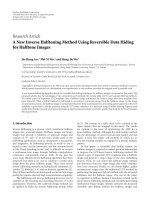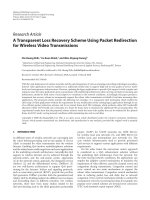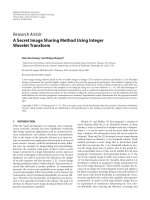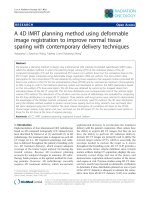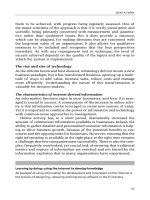A multicriteria decision making method using aggregation operators for simplified neutrosophic sets
Bạn đang xem bản rút gọn của tài liệu. Xem và tải ngay bản đầy đủ của tài liệu tại đây (105.97 KB, 9 trang )
2459
Journal of Intelligent & Fuzzy Systems 26 (2014) 2459–2466
DOI:10.3233/IFS-130916
IOS Press
A multicriteria decision-making method
using aggregation operators for simplified
neutrosophic sets
Jun Ye∗
Department of Electrical and Information Engineering, Shaoxing University, Shaoxing,
Zhejiang Province, P.R. China
Abstract. The paper introduces the concept of simplified neutrosophic sets (SNSs), which are a subclass of neutrosophic sets, and
defines the operational laws of SNSs. Then, we propose some aggregation operators, including a simplified neutrosophic weighted
arithmetic average operator and a simplified neutrosophic weighted geometric average operator. Based on the two aggregation
operators and cosine similarity measure for SNSs, a multicriteria decision-making method is established in which the evaluation
values of alternatives with respective to criteria are represented by the form of SNSs. The ranking order of alternatives is performed
through the cosine similarity measure between an alternative and the ideal alternative and the best one(s) can be determined as
well. Finally, a numerical example shows the application of the proposed method.
Keywords: Neutrosophic set, simplified neutrosophic set, operational laws, aggregation operator, cosine similarity measure,
multicriteria decision-making
1. Introduction
Intuitionistic fuzzy sets [9] and interval-valued intuitionistic fuzzy sets [10] can only handle incomplete
information but not the indeterminate information and
inconsistent information which exist commonly in real
situations. Then, the neutrosophic set proposed by
Smarandache is a powerful general formal framework
which generalizes the concept of the classic set, fuzzy
set [11], interval valued fuzzy set [6], intuitionistic
fuzzy set [9], interval-valued intuitionistic fuzzy set
[10], paraconsistent set [1], dialetheist set [1], paradoxist set [1], and tautological set [1]. So the notion
of neutrosophic sets is more general and overcomes the
∗ Corresponding author. Jun Ye, Department of Electrical and
Information Engineering, Shaoxing University, 508 Huancheng West
Road, Shaoxing, Zhejiang Province 312000, P.R. China. Tel.: +86 575
88327323; E-mail:
aforementioned issues. In the neutrosophic set, indeterminacy is quantified explicitly and truth-membership,
indeterminacy-membership, and false-membership are
independent. This assumption is very important in
many applications such as information fusion in
which the data are combined from different sensors.
Recently, neutrosophic sets have been applied to image
thresholding, image denoise applications, and image
segmentation. Cheng and Guo [3] proposed a thresholding algorithm based on neutrosophy, which could select
the thresholds automatically and effectively. Guo et al.
[18] defined some concepts and operators based on neutrosophic sets and applied them for image denoising,
which can process not only noisy images with different
levels of noise, but also images with different kinds of
noise well. Guo and Cheng [19] applied neutrosophic
sets to process the images with noise and proposed a
novel neutrosophic approach for image segmentation.
1064-1246/14/$27.50 © 2014 – IOS Press and the authors. All rights reserved
2460
J. Ye / A multicriteria decision-making method using aggregation operators
In any multicriteria decision-making problem, the
final solution must be obtained from the synthesis of
performance degrees of criteria [2]. To do this, the
aggregation of information is fundamental. Therefore,
many researchers have developed a variety of aggregation operators with assessment on [0, 1] [12–15,
20–22], proportional assessment on [1/9, 9] [2], and
linguistic assessment [16, 17]. Then two of the most
common operators for aggregating arguments are the
weighted arithmetic average operator and the weighted
geometric average operator [20–22], which have been
wildly applied to decision-making problems. Therefore, these aggregation operators are important tools
for aggregating fuzzy information, intuitionistic fuzzy
information, interval-valued fuzzy information, and
interval-valued intuitionistic fuzzy information in the
decision-making problems. Whereas the neutrosophic
set generalizes the above mentioned sets from philosophical point of view. From scientific or engineering
point of view, the neutrosophic set and set-theoretic
operators need to be specified. Otherwise, it will be
difficult to apply it to the real applications. Therefore, Wang et al. [4] proposed interval neutrosophic
sets (INSs) and some operators of INSs. Then, Ye [7]
defined the Hamming and Euclidean distances between
INSs and developed the similarity measures between
INSs based on the relationship between similarity measures and distances and a multicriteria decision-making
method using the similarity measures between INSs in
interval neutrosophic setting, in which criterion values with respect to alternatives are evaluated by the
form of INSs. Recently, Wang et al. [5] proposed a
single valued neutrosophic set (SVNS), which is an
instance of the neutrosophic set, and provide the settheoretic operators and various properties of SVNSs.
Furthermore, Ye [8] presented the information energy
of SVNSs, correlation of SVNSs, correlation coefficient of SVNSs, and weighted correlation coefficient
of SVNSs based on the extension of the correlation
of intuitionistic fuzzy sets and demonstrated that the
cosine similarity measure is a special case of the correlation coefficient in single valued neutrosophic setting,
and then applied them to single valued neutrosophic
decision-making problems. Meanwhile, motivated by
some intuitionistic fuzzy aggregation operators with
assessment on [0, 1] [20–22], we can also extend
them to neutrosophic sets. Thus, it will be necessary
to develop some aggregation operators for aggregating neutrosophic information in the decision-making
applications. To do so, the main purposes of this paper
are to define the concept of simplified neutrosophic
sets (SNSs), which can be described by three real
numbers in the real unit interval [0, 1], and some
operational laws for SNSs and to propose two aggregation operators, including a simplified neutrosophic
weighted arithmetic average operator and a simplified neutrosophic weighted geometric average operator.
Then, a multicriteria decision-making method using
the two aggregation operators of SNSs is established
in which the evaluation information of alternatives
with respect to criteria is given by truth-membership
degree, indeterminacy-membership degree, and falsitymembership degree under the simplified neutrosophic
environment. And then the ranking order of alternatives is performed through the cosine similarity measure
between an alternative and the ideal alternative and the
best choice can be obtained according to the measure
values. However, the main advantage of the proposed
simplified neutrosophic multicriteria decision-making
method can handle not only incomplete information
but also the indeterminate information and inconsistent
information which exist commonly in real situations.
The rest of paper is organized as follows. Section 2 introduces the some concepts of neutrosophic
sets. SNSs and some operational laws are defined
and two simplified neutrosophic weighted aggregation
operators are proposed in Section 3. The two simplified neutrosophic weighted aggregation operators and
cosine similarity measure for SNSs are applied to a multicriteria decision-making problem under the simplified
neutrosophic environment and through the cosine similarity measure between each alternative and the ideal
alternative, the ranking order of alternatives and the best
one(s) can be obtained in Section 4. In Section 5, a
numerical example demonstrates the application of the
proposed decision-making method. Finally, some final
remarks and future research are offered in Section 6.
2. Some concepts of neutrosophic sets
Neutrosophic set is a part of neutrosophy, which
studies the origin, nature, and scope of neutralities, as
well as their interactions with different ideational spectra [1], and is a powerful general formal framework.
Neutrosophic set permits one to incorporate indeterminacy, hesitation and/or uncertainty independent of the
membership and non-membership information. Thus
the notion of neutrosophic set is a generalization of
fuzzy, intuitionistic fuzzy, and interval-valued sets.
Smarandache [1] gave the following definition of a
neutrosophic set.
J. Ye / A multicriteria decision-making method using aggregation operators
Definition 1. [1] Let X be a space of points (objects),
with a generic element in X denoted by x. A neutrosophic set A in X is characterized by a truth-membership
function TA (x), an indeterminacy-membership function
IA (x) and a falsity-membership function FA (x). The
functions TA (x), IA (x) and FA (x) are real standard or
nonstandard subsets of ]0– , 1+ [, that is TA (x): X −→
]0– , 1+ [, IA (x): X −→ ]0– , 1+ [, and FA (x): X −→ ]0– ,
1+ [.
There is no restriction on the sum of TA (x), IA (x) and
FA (x), so 0– ≤sup TA (x)+sup IA (x)+sup FA (x)≤3+ .
Definition 2. [1] The complement of a neutrosophic
c (x ) =
set A is denoted by Ac and is defined as TA
c
+
+
{1 } TA (x ), IA (x ) = {1 } IA (x ), and FA c (x )
= {1+ } FA (x ) for every x in X.
Definition 3. [1] A neutrosophic set A is contained in
the other neutrosophic set B, A ⊆ B if and only if inf
TA (x)≤inf TB (x), sup TA (x)≤sup TB (x), inf IA (x)≥inf
IB (x), sup IA (x)≥sup IB (x), inf FA (x)≥inf FB (x), and
sup FA (x)≥sup FB (x) for every x in X.
Definition 4. [1] The union of two neutrosophic sets
A and B is a neutrosophic set C, written as C = A∪B,
whose truth-membership, indeterminacy membership
and false-membership functions are related to those of
A and B by TC (x)=TA (x) ⊕ TB (x)
TA (x)
TB (x),
IC (x) = IA (x) ⊕ IB (x) IA (x) IB (x), and FC (x) = FA (x)
⊕ FB (x) FA (x) FB (x) for any x in X.
Definition 5. [1] The intersection of two neutrosophic
sets A and B is a neutrosophic set C, written as C = A ∩ B,
whose truth-membership, indeterminacy-membership
and false-membership functions are related to those of
A and B by TC (x) = TA (x) TB (x), IC (x) = IA (x) IB (x),
and FC (x) = FA (x) FB (x) for any x in X.
2461
of SNSs, which are a subclass of neutrosophic sets,
and the operational laws of SNSs, then propose two
weighted aggregation operators of SNSs for the information aggregation in neutrosophic decision making
problems.
Definition 6. Let X be a space of points (objects),
with a generic element in X denoted by x. A neutrosophic set A in X is characterized by a truth-membership
function TA (x), a indeterminacy-membership function
IA (x) and a falsity-membership function FA (x). If the
functions TA (x), IA (x) and FA (x) are singleton subintervals/subsets in the real standard [0, 1], that is TA (x): X
−→ [0, 1], IA (x): X −→ [0, 1], and FA (x): X −→ [0,
1]. Then, a simplification of the neutrosophic set A is
denoted by
A = { x, TA (x), IA (x), FA (x) |x ∈ X}
which is called a SNS. It is a subclass of neutrosophic
sets.
In this paper, we shall use the SNS whose TA (x),
IA (x) and FA (x) values are single points in the real
standard [0, 1] instead of subintervals/subsets in the
real standard [0, 1]. Thus, each SNS can be described
by three real numbers in the real unit interval [0, 1].
Therefore, the sum of TA (x ) ∈ [0, 1], IA (x ) ∈ [0, 1]
and FA (x ) ∈ [0, 1] satisfies the condition 0 ≤ TA (x ) +
IA (x ) + FA (x ) ≤ 3. For the sake of simplicity, the SNS
A = { x, TA (x), IA (x), FA (x) |x ∈ X} is denoted by
the simplified symbol A = TA (x), IA (x), FA (x) . In
this case, we can give the following definitions.
Definition 7. The SNS A is contained in the other SNS
B, A ⊆B if and only if TA (x)≤TB (x), IA (x)≥IB (x), and
FA (x)≥FB (x) for every x in X.
Definition 8. Let A, B are two SNSs. Operational relations are defined by
3. Operational relations of SNSs
Smarandache [1] has provided a variety of real-life
examples for possible applications of his neutrosophic
sets, which are comprised of three subsets of the nonstandard interval ]0– , 1+ [, i.e., TA (x) ⊆]0– , 1+ [, IA (x)
⊆]0– , 1+ [, and FA (x) ⊆]0– , 1+ [. However, it is difficult to apply neutrosophic sets to practical problems.
Therefore, we will reduce neutrosophic sets of nonstandard intervals into a kind of SNSs of standard
intervals that will preserve the operations of the neutrosophic sets. In this section, we introduce the concept
A + B = TA (x) + TB (x) − TA (x)TB (x),
IA (x) + IB (x) − IA (x)IB (x),
FA (x) + FB (x) − FA (x)FB (x)
(1)
A · B = TA (x)TB (x), IA (x) IB (x),
FA (x)FB (x)
(2)
λA = 1 − (1 − TA (x))λ , 1 − (1 − IA (x))λ ,
1 − (1 − FA (x))λ , λ > 0
(3)
2462
J. Ye / A multicriteria decision-making method using aggregation operators
Aλ = TAλ (x), IAλ (x), FAλ (x) , λ > 0
(4)
Based on the above operational laws, we can propose
the following weighted arithmetic aggregation operator and weighted geometric aggregation operator for
SNSs.
Definition 9. Let Aj (j = 1, 2, . . . , n) be a SNS. The
simplified neutrosophic weighted arithmetic average
operator is defined by
w1 A1 = 1 − (1 − TA1 (x))w1 , 1 − (1 − IA1 (x))w1 ,
1 − (1 − FA1 (x))w1 ,
w2 A2 = 1 − (1 − TA2 (x))w2 , 1 − (1 − IA2 (x))w2 ,
1 − (1 − FA2 (x))w2 .
Thus,
Fw (A1 , A2 ) = w1 A1 + w2 A2
n
Fw (A1 , A2 , . . . , An ) =
Proof. The proof of Equation (7) can be done by means
of mathematical induction.
(1) When n = 2, then,
wj Aj
(5)
j=1
= 2 − (1 − TA1 (x))w1 − (1 − TA2 (x))w2
−(1 − (1 − TA1 (x))w1 )(1 − (1 − TA2 (x))w2 ),
2 − (1 − IA1 (x))w1 − (1 − IA2 (x))w2
where W = (w1 , w2 , . . . , wn ) is the weight vector
of Aj (j = 1, 2, . . . , n), wj ∈ [0, 1] and
n
j=1
wj = 1.
Especially, Assume W = (1/n, 1/n, . . . , 1/n), then Gw
is called as an arithmetic average operator for SNSs.
Definition 10. Let Aj (j = 1, 2, . . . , n) be a SNS. The
simplified neutrosophic weighted geometric average
operator is defined by
n
Gw (A1 , A2 , . . . , An ) =
j=1
n
j=1
2 − (1 − FA1 (x))w1 − (1 − FA2 (x))w2
−(1 − (1 − FA1 (x))w1 )(1 − (1 − FA2 (x))w2 )
= 1 − (1 − TA1 (x))w1 (1 − TA2 (x))w2 ,
1 − (1 − IA1 (x))w1 (1 − IA2 (x))w2 ,
1 − (1 − FA1 (x))w1 (1 − FA2 (x))w2
w
Aj j
(6)
Fw (A1 , A2 , . . . , Ak ) =
1−
k
1−
Theorem 1. For a SNS Aj (j = 1, 2, . . . , n), we have the
following result by use of Equation (5):
1−
n
1−
j=1
1−
j=1
k
(1 − FAj )wj
(1 − IAj (x)) ,
k
=
1−
(1 − TAj (x))wj
j=1
n
(1 − FAj (x))
wj
(7)
j=1
+(1 − (1 − TAk+1 (x))wk+1 )
k
where W=(w1 , w2 , . . . , wn ) is the weight vector of Aj
(j = 1, 2, . . . , n), wj ∈ [0, 1] and
n
j=1
wj = 1.
(9)
j=1
Fw (A1 , A2 , . . . , Ak+1 )
wj
j=1
1−
(1 − IAj )wj ,
(3) When n = k+1, by applying Equations (8) and (9),
we can get
(1 − TAj (x))wj ,
n
(1 − TAj )wj ,
j=1
wj = 1. Especially,
Assume W = (1/n, 1/n, . . . , 1/n), then Gw is called as
an geometric average operator for SNSs.
Fw (A1 , A2 , . . . , An ) =
(8)
(2) When n = k, by applying Equation (7), we get
k
where W = (w1 , w2 , . . . , wn ) is the weight vector of Aj
(j = 1, 2, . . . , n), wj ∈ [0, 1] and
−(1 − (1 − IA1 (x))w1 )(1 − (1 − IA2 (x))w2 ),
−(1 −
(1 − TAj (x))wj )
j=1
(1 − (1 − TAk+1 (x))wk+1 ),
J. Ye / A multicriteria decision-making method using aggregation operators
k
1−
Theorem 2. For a SNS Aj (j = 1, 2, . . . , n), we have the
following result by applying Equation (6):
(1 − IAj (x))wj
j=1
Gw (A1 , A2, . . . , An )
+(1 − (1 − IAk+1 (x))wk+1 )
k
n
=
j=1
(1 − IAj (x))wj )
−(1 −
(1 − (1 − IAk+1 (x))
k
1−
+(1 − (1 − FAk+1 (x))wk+1 )
(1 − (1 − FAk+1 (x))wk+1 )
k+1
1−
(1 − TAj (x))wj ,
j
A+ =
wj
1−
(1 − IAj (x)) ,
j=1
k+1
1−
(1 − FAj (x))wj
(10)
j=1
Therefore, considering the above results, we have
Equation (7) for any n. This completes the proof.
It is obvious that the Fw operator has the following
properties:
(1) Idempotency: Let Aj (j = 1, 2,..., n) be a collection
of SNSs. If Ai (j = 1, 2,..., n) is equal, i.e. Aj = A for
j = 1, 2,..., n, then Fw (A1 , A2 , . . . , An ) = A.
(2) Boundedness:
Let
Aj (j = 1, 2, ..., n)
be a collection of SNSs and let A− =
min TAj (x), max IAj (x), max FAj (x)
j
A+ =
j
j
and
max TAj (x), min IAj (x), min FAj (x)
j
j
w
j=1
FAjj (x) (11)
n
j=1
wj = 1.
min TAj (x), max IAj (x), max FAj (x)
j=1
k+1
n
(1) Idempotency: Let Aj (j = 1, 2, ..., n) be a
collection of SNSs. If Ai (j = 1, 2,..., n)
is equal, i.e. Aj = A for j = 1, 2,..., n, then
Gw (A1 , A2 , . . . , An ) = A.
(2) Boundedness: Let Aj (j = 1, 2, ..., n) be
a collection of SNSs and let A− =
(1 − FAj (x))wj )
j=1
=
j=1
w
IAjj (x),
By a similar proof manner, we can give the proof of
Theorem 2 (omitted).
It is obvious that the Gw operator has the following
properties:
j=1
k
n
(j = 1, 2, . . . , n), wj ∈ [0, 1] and
),
(1 − IAj (x))wj
−(1 −
w
TAjj (x),
where W = (w1 , w2 , . . . , wn ) is the weight vector of Aj
j=1
wk+1
2463
j
for j = 1, 2,..., n, then A− ⊆ Fw (A1 , A2 , . . . ,
An ) ⊆ A+ .
(3) Monotonity: Let Aj (j = 1, 2, ..., n) be
a collection of SNSs. If Aj ⊆Aj ∗ for
j = 1, 2,..., n, then Fw (A1 , A2 , . . . , An ) ⊆
Fw A∗1 , A∗2 , . . . , A∗n .
j
j
and
max TAj (x), min IAj (x), min FAj (x)
j
j
for j = 1, 2, ..., n, then
A2 , . . . , An ) ⊆ A+ .
(3) Monotonity: Let Aj (j = 1,
a collection of SNSs. If
j = 1, 2, ..., n, then Gw (A1 ,
Gw A∗1 , A∗2 , . . . , A∗n .
j
A− ⊆ Gw (A1 ,
2, ..., n) be
Aj ⊆Aj ∗ for
A2 , . . . , An ) ⊆
The aggregation results Fw and Gw are still SNSs.
Obviously, there are different focal points between
Equations (7) and (11). The weighted arithmetic average operator emphasizes group’s major points, and then
the weighted geometric average operator emphasizes
personal major points.
4. Decision-making method based on the
simplified neutrosophic weighted
aggregation operators
In this section, we present a handling method for
multicriteria decision-making problems by means of
the two aggregation operators and cosine similarity
measure for SNSs under the simplified neutrosophic
environment.
Let A = {A1 , A2 , . . . , Am } be a set of alternatives and
let C = {C1 , C2 , . . . , Cn } be a set of criteria. Assume
that the weight of the criterion Cj (j = 1, 2, . . . , n),
2464
J. Ye / A multicriteria decision-making method using aggregation operators
entered by the decision-maker, is wj , wj ∈ [0, 1] and
n
j=1 wj = 1. In the decision process, the evaluation
information of the alternative Ai on the criteria is represented by the form of a SNS:
Ai =
Cj , TAi (Cj ), IAi (Cj ), FAi (Cj ) |Cj ∈ C ,
where 0 ≤ TAi (Cj ) + IAi (Cj ) + FAi (Cj ) ≤ 3, TAi (Cj )
≥ 0, IAi (Cj ) ≥ 0, FAi (Cj ) ≥ 0, j = 1, 2, . . . , n, and
i = 1, 2, . . . , m. For convenience, the value of SNSs
is denoted by αij = tij , iij , fij (i = 1, 2, . . . , m; j = 1, 2,
. . . , n). Therefore, we can get a simplified neutrosophic
decision matrix D = (αij )m×n :
⎡
D = (αij )m×n
t11 , i11 , f11
⎢
⎢ t21 , i21 , f21
⎢
=⎢
..
⎢
.
⎣
tm1 , im1 , fm1
t12 , i12 , f12
t22 , i22 , f22
..
.
=
ti ti∗ + ii i∗i + fi fi∗
ti2 + i2i + fi2
ti
ti∗
2
· · · t1n , i1n , f1n
· · · t2n , i2n , f2n
..
..
.
.
tm2 , im2 , fm2 · · · tmn , imn , fmn
Then, the aggregating simplified neutrosophic value
αi for Ai (i = 1, 2, . . . , m) is αi = ti , ii , fi = Fiw (αi 1 , αi 2 ,
. . . , αi n ) or αi = ti , ii , fi = Giw (αi 1 , αi 2 , . . . , αi n ) is
obtained by applying Equations (7) or (11) according to
each row in the simplified neutrosophic decision matrix
D = (aij )m ×n .
To rank alternatives in the decision-making process,
we define an ideal SNS value as the ideal alternative
␣∗ = 1, 0, 0 , and then based on the cosine similarity
measure between SVNSs proposed by Ye [8], the cosine
similarity measure between SNSs ␣i (i = 1, 2,..., m) and
␣∗ can be defined as follows:
Si (αi , α∗ ) =
Step 1: Calculate the weighted arithmetic average
values by using Equation (7) or the weighted
geometric average values by using Equation
(11)
Step 2: Calculate the cosine similarity measure
between each alternative and the ideal alternative by using Equation (12).
Step 3: Give the ranking order of the alternatives
from the obtained measure values, and then
get the best choice.
Step 4: End.
+ i∗i
2
+ fi∗
2
(12)
ti2 + i2i + fi2
Then, the bigger the measure value Si (␣i , ␣∗ ) (i = 1,
2,..., m) is, the better the alternative Ai is, because
the alternative Ai is close to the ideal alternative ␣∗ .
Through the cosine similarity measure between each
alternative and the ideal alternative, the ranking order
of all alternatives can be determined and the best one
can be easily identified as well.
In summary, the decision procedure for the proposed
method can be summarized as follows:
⎤
⎥
⎥
⎥
⎥.
⎥
⎦
5. Numerical example
In this section, an example for a multicriteria
decision-making problem of engineering alternatives
is used as a demonstration of the application of the
proposed decision-making method in a realistic scenario, as well as the application and effectiveness of the
proposed decision-making method.
Let us consider the decision-making problem
adapted from [8]. There is an investment company,
which wants to invest a sum of money in the best option.
There is a panel with four possible alternatives to invest
the money: (1) A1 is a car company; (2) A2 is a food
company; (3) A3 is a computer company; (4) A4 is an
arms company. The investment company must take a
decision according to the following three criteria: (1)
C1 is the risk; (2) C2 is the growth; (3) C3 is the environmental impact. Then, the weight vector of the criteria is
given by W = (0.35, 0.25, 0.4), which is adopted from
the literature [8].
For the evaluation of an alternative Ai (i = 1, 2, 3, 4)
with respect to a criterion Cj (j = 1, 2, 3), it is obtained
from the questionnaire of a domain expert. For example,
when we ask the opinion of an expert about an alternative A1 with respect to a criterion C1 , he or she may say
that the possibility in which the statement is good is 0.4
J. Ye / A multicriteria decision-making method using aggregation operators
and the statement is poor is 0.3 and the degree in which
he or she is not sure is 0.2. For the neutrosophic notation, it can be expressed as ␣11 = 0.4, 0.2, 0.3 . Thus,
when the four possible alternatives with respect to the
above three criteria are evaluated by the expert, we can
obtain the following simplified neutrosophic decision
matrix D:
⎡
⎤
0.4, 0.2, 0.3 0.4, 0.2, 0.3 0.2, 0.2, 0.5
⎢
⎥
⎢ 0.6, 0.1, 0.2 0.6, 0.1, 0.2 0.5, 0.2, 0.2 ⎥
⎢
⎥.
D=⎢
⎥
⎣ 0.3, 0.2, 0.3 0.5, 0.2, 0.3 0.5, 0.3, 0.2 ⎦
0.7, 0.0, 0.1
0.6, 0.1, 0.2
0.4, 0.3, 0.2
The proposed method is applied to solve this
problem according to the following computational
procedure:
Step 1: We can obtain the weighted arithmetic
average value (aggregating simplified neutrosophic value) ␣i for Ai (i = 1, 2, 3, 4) by
using Equation (7):
␣1 = 0.3268, 0.2000, 0.3881 , ␣2 =
0.5627, 0.1414, 0.2000 , ␣3 = 0.4375,
0.2416, 0.2616 , and ␣4 = 0.5746, 0.1555,
0.1663 .
Step 2: By applying Equation (12), we can compute each cosine similarity measure Si (␣i ,
␣∗ ) (i = 1, 2, 3, 4) as follows:
S1 (␣1 , ␣∗ ) = 0.5992, S2 (␣2 , ␣∗ ) = 0.9169,
S3 (␣3 , ␣∗ ) = 0.7756, and S4 (␣4 , ␣∗ ) =
0.9297.
Step 3: From the measure value Si (␣i , ␣∗ ) (i = 1, 2, 3,
4) between an alternative and the ideal alternative, the ranking order of four alternatives
is A4 A2 A3 A1 .
Therefore, we can see that the alternative A4 is the
best choice among all the alternatives.
On the other hand, we can also utilize the weighted
geometric average operator as the following computational procedure:
Step 1’: We compute the weighted geometric average values by applying Equation (11) for Ai
(i = 1, 2, 3, 4), each aggregating simplified
neutrosophic value ␣i (i = 1, 2, 3, 4) is as
follows:
␣1 = 0.3031, 0.2000, 0.3680 , ␣2 =
0.5578, 0.1320, 0.2000 , ␣3 = 0.4181,
0.2352, 0.2551 , and ␣4 = 0.5385, 0,
0.1569 .
2465
Step 2’: By using Equation (12), we can compute
each cosine similarity measure Si (␣i , ␣∗ )
(i = 1, 2, 3, 4) as follows:
S1 (␣1 , ␣∗ ) = 0.5863, S2 (␣2 , ␣∗ ) = 0.9188,
S3 (␣3 , ␣∗ ) = 0.7696, and S4 (␣4 , ␣∗ ) =
0.9601.
Step 3’: The ranking order of four alternatives is A4
A2 A3 A1 . Thus, we can see that the
alternative A4 is still the best choice among
all the alternatives.
Obviously, we can see that the above two kinds of
ranking orders and the best alternative are the same.
The method proposed in this paper differs from
existing approaches for fuzzy multi-criteria decision
making not only due to the fact that the proposed
method uses the SNS concept and two simplified neutrosophic aggregation operators, but also due to the
consideration of the indeterminacy information besides
truth and falsity information in the evaluation of the
alternative with respect to criteria, which makes it
have more feasible and practical than other traditional
decision making methods in real decision-making problems. Therefore, its advantage is easily reflecting the
ambiguous nature of subjective judgments because
SNSs are suitable for capturing imprecise, uncertain,
and inconsistent information in the multicriteria decision analysis.
6. Conclusion
This paper introduced the concept of SNSs, which
are a subclass of neutrosophic sets, and defined some
operational laws of SNSs. Then, we proposed two
aggregation operators for SNSs, including a simplified
neutrosophic weighted arithmetic average operator and
a simplified neutrosophic weighted geometric average
operator. The two aggregation operators were applied
to multicriteria decision-making problems under the
simplified neutrosophic environment, in which criterion values with respect to alternatives are evaluated
by the form of simplified neutrosophic values and the
criterion weights are known information. We utilized
the cosine similarity measure between an alternative
and the ideal alternative to rank the alternatives and
to determine the best one(s) according to the measure
values. Finally, a numerical example is provided to
illustrate the application of the developed approach.
The proposed simplified neutrosophic multicriteria
decision-making method is more suitable for real scien-
2466
J. Ye / A multicriteria decision-making method using aggregation operators
tific and engineering applications because it can handle
not only incomplete information but also the indeterminate information and inconsistent information which
exist commonly in real situations. The techniques proposed in this paper can provide more useful way for
decision-makers. In the future, we shall deal with group
decision making problems with incomplete decision
contexts and preference relations performed in the
selection process under the simplified neutrosophic
environment and apply the simplified neutrosophic
aggregation operators to solve practical applications in
other areas such as expert system, information fusion
system, and medical diagnoses.
[9]
[10]
[11]
[12]
[13]
[14]
References
[15]
[1]
[2]
[3]
[4]
[5]
[6]
[7]
[8]
F. Smarandache, A unifying field in logics. Neutrosophy: Neutrosophic probability, set and logic, American Research Press,
Rehoboth 1999.
F. Herrera, E. Herrera-Viedma and F. Chiclana, A study of
the origin and uses of the ordered weighted geometric operator in multicriteria decision making, International Journal of
Intelligent Systems 18(6) (2003), 689–707.
H.D. Cheng and Y. Guo, A new neutrosophic approach to
image thresholding, New Mathematics and Natural Computation 4(3) (2008), 291–308.
H. Wang, F. Smarandache Y.Q. Zhang et al., Interval neutrosophic sets and logic: Theory and applications in computing,
Hexis, Phoenix, AZ 2005.
H. Wang, F. Smarandache Y.Q. Zhang, et al., Single valued
neutrosophic sets, Multispace and Multistructure 4 (2010),
410–413.
I. Turksen, Interval valued fuzzy sets based on normal forms,
Fuzzy Sets and Systems 20 (1986), 191–210.
J. Ye, Similarity measures between interval neutrosophic sets
and their applications in multicriteria decision-making, Journal of Intelligent & Fuzzy Systems, DOI: 10.3233/IFS-120724
(2013).
J. Ye, Multicriteria decision-making method using the correlation coefficient under single-valued neutrosophic environment,
[16]
[17]
[18]
[19]
[20]
[21]
[22]
International Journal of General Systems 42(4) (2013),
386–394.
K. Atanassov, Intuitionistic fuzzy sets, Fuzzy Sets and Systems
20 (1986), 87–96.
K. Atanassov and G. Gargov, Interval valued intuitionistic
fuzzy sets, Fuzzy Sets and Systems 31 (1989), 343–349.
L.A. Zadeh, Fuzzy Sets, Information and Control 8 (1965),
338–353.
P.D. Liu, A weighted aggregation operators multi-attribute
group decision-making method based on interval-valued trapezoidal fuzzy numbers, Expert Systems with Applications 38(1)
(2011), 1053–1060.
P.D. Liu and F. Jin, A multi-attribute group decision-making
method based on weighted geometric aggregation operators
of interval-valued trapezoidal fuzzy numbers, Applied Mathematical Modelling 36(6) (2012), 2498–2509.
P.D. Liu, X. Zhang and F. Jin, A multi-attribute group decisionmaking method based on interval-valued trapezoidal fuzzy
numbers hybrid harmonic averaging operators, Journal of
Intelligent & Fuzzy Systems 23(5) (2012), 159–168.
P.D. Liu, Some Hamacher aggregation operators based on the
interval-valued intuitionistic fuzzy numbers and their application to group decision making, IEEE Transactions on Fuzzy
systems, (2013). DOI: 10.1109/TFUZZ.2013.2248736
P.D. Liu, Some generalized dependent aggregation operators
with intuitionistic linguistic numbers and their application to
group decision making, Journal of Computer and System Sciences 79(1) (2013), 131–143.
P.D. Liu and F. Jin, Methods for aggregating intuitionistic
uncertain linguistic variables and their application to group
decision making, Information Sciences 205 (2012), 58–71.
Y. Guo, H.D. Cheng, Y. Zhang and W. Zhao, A new neutrosophic approach to image denoising, New Mathematics and
Natural Computation 5(3) (2009), 653–662.
Y. Guo and H.D. Cheng, New neutrosophic approach to image
segmentation, Pattern Recognition 42 (2009), 587–595.
Z.S. Xu and R.R. Yager, Some geometric aggregation operators based on intuitionistic fuzzy sets, International Journal of
General System 35 (2006), 417–433.
Z.S. Xu, Intuitionistic fuzzy aggregation operators, IEEE
Transactions on Fuzzy Systems 15(6) (2007), 1179–
1187.
Z.S. Xu, Methods for aggregating interval-valued intuitionistic
fuzzy information and their application to decision making,
Control and decision 22(2) (2007), 215–219.
Copyright of Journal of Intelligent & Fuzzy Systems is the property of IOS Press and its
content may not be copied or emailed to multiple sites or posted to a listserv without the
copyright holder's express written permission. However, users may print, download, or email
articles for individual use.

